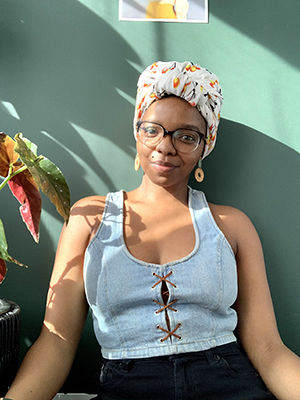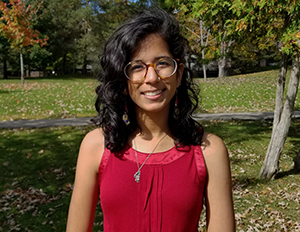Capacity for Plurality: Manahil Bandukwala interviews Liselle Yorke

Past contributor Manahil Bandukwala talks with Liselle Yorke, whose poems "caves" and "off the page" appear in our winter issue #225. They discuss the unsaid aspects of a poem, the desire for balance, and Liselle’s current project combining ceramics and poetry.
Liselle Yorke is a Trinidadian-Canadian artist, who uses poetry to express a desire to rid herself of assumptions and instead dig into people, society and herself with an untethered sense curiosity that does not seek neat conclusions. Her writing strives to create windows that display a community who celebrates, protects, and respects life and individuality. Her work has been featured in publications such as Event magazine, CV2, Carte Blanche, and Plenitude.
The rhythm of your poem “caves” feels like a dance with how fluid the lines are. What especially struck me was the line breaks—for example, “shifts into the familiar / into we’ve been there / the beachfront alive / with moving shells.” For you, what does it mean to create a poem from start to finish?
I try to show up to writing daily, be it poetry or journaling. If there’s an opportunity to create something beautiful, I was in attendance. Pieces written with this intention feel more like creating, like I’m a sculptor and the poem is being pulled out of the medium of writing.
Other times poetry feels like channeling; the words come in loud and barreling or quiet and incessant, either way I must write. These pieces feel like collaborating with the universe and spiritual guides; like following a rhythm.
Regardless of how a poem begins, the end of a poem is dictated by mouthfeel. It’s repeated aloud until it feels right being spoken, which usually means it will sound as it’s meant to be.
Music is often present when I write. Sometimes a particular song might put me in a writing flow and I’ll play that sound on repeat until the piece is complete. If the poem needs more than one sitting, I know that putting its song on will put me back into the mode of the piece. Many of my poems are written in silence or to the sound of nature; for example “caves” was written to the restless shuffling of hundreds of hermit crabs and the constant crash of ocean waves, but many poems also have an accompanying song.
Nature also plays a central role in my writing. I often venture out into nature to write; the more time I spend there, the more I see the origin of human ideas. Referencing nature is as natural to me as referencing and relating to oneself.
I prefer to be alone when writing. I try to express the piece as honestly and selfishly as possible. This process allows me to be at peace with the finished work no matter what. Beyond that, if the work is shared and it connects with others, those connections feel very meaningful to me. It’s like I’ve found the string that connects us and I seek to build community from that space.
“off the page” leans into plurality and multiplicity, both the kind that is evident and out there, and that which is hidden. In the second half of the poem, you dive into the contradiction of “Canadian niceness.” What makes poetry a good medium to explore the duality of plurality?
Poetry often embodies much plurality. When you read a poem, you’re always holding several truths: the author’s truth, the suspended reality of the poem is its own truth, and the truth of your own life experiences that you see reflected in the piece.
In “off the page” I share an experience of normalized exclusion and oppression as a Canadian. If a reader is holding the singular truth of “Canadians are nice, full stop” then the poem offers them another true singular experience.
I think where many people experience discomfort with plurality is thinking that in order accept another offered truth you must first let go of the one you’re currently holding. This type of thinking creates rigidity and limits one’s perspective. With poetry the reader is instead invited to hold both truths and learn that they possess a great capacity for plurality.
I think that plurality contains much grace and humanity, and that being able to embody it allows for a more expansive and balanced life.
“off the page” also puts an emphasis on the unsaid. Both in these poems in The Malahat Review and beyond, what do you make of the relationship between the words in a poem and the unsaid aspect of a poem?
I think the words of a poem do their best to reflect as close to the poet’s meaning as possible, but the unsaid aspect can be space for emotion that is too big or nuanced for words to capture and convey with any accuracy. Emotions that the poet themself may not have yet processed, but will later look back at and feel clearly what the piece was trying to express.
The unsaid aspect of a poem also creates space for the reader to connect, to feel their personal experiences reflected in the piece. In this way, the words of a poem are a call and the unsaid aspect of the poem is the reader’s opportunity to respond. As satisfying as it is to write a piece that I believe truly conveys my intended meaning, I’m also grateful that poetry leaves room in the margins.
You work in multidisciplinary mediums, including ceramics. What do you see as a benefit of working between or within practices?
I’m a third-generation woodworker and am very comfortable working with my hands. When I started exploring clay, hand building felt familiar and stoked my curiosity. The more I played, the more I learned that clay is a very vocal medium with a deep reservoir for self-expression. The type of clay, earthenware or porcelain, glazed or unglazed, textured or smooth, can evoke different reactions and imply the functionality of a piece.
As a poet my work exists in books and sits on shelves, I became very envious of painters, the way their work is displayed on the walls of homes and really gets to live with people. My desire to have poetry be a bigger part of people’s everyday lives is how I started on a journey to marry clay and poetry. Over the last year, I’ve been working on a project that does just that. The text of my poems has been carved, painted, decal-ed onto or made entirely out of clay. The clay can speak with the poem, it can contradict, embellish or even convey what’s there but not said in the poem through shape, texture, colour, and finish. These pieces can be wall mounted or rest on table tops, they are present.
What I’ve learnt as a multidisciplinary artist is perhaps how to listen to what different mediums of art have to say and how they choose to express it.
What is a piece of writing (a poem, an article, a song) that inspired you in 2023?
The band Half Moon Run have a song titled “Gigafire” from their album Salt that I’ve listen to a lot over this past year. There are these four lines that are repeated twice:
“I lay before mother’s grave when link
was severed
and how we broke the ring of time baby aren’t
we clever, uh huh”
The first rendition of the lines feels celebratory, a nod to human ambition. Whereas the second rendition is sung with much more force, raw, and the impression is more the havoc of hubris. The song seems to be highlighting a need for balance; at least this is my interpretation of it and that’s what draws me in as a desire for balance is also a repeated theme in my own work.

Manahil Bandukwala









